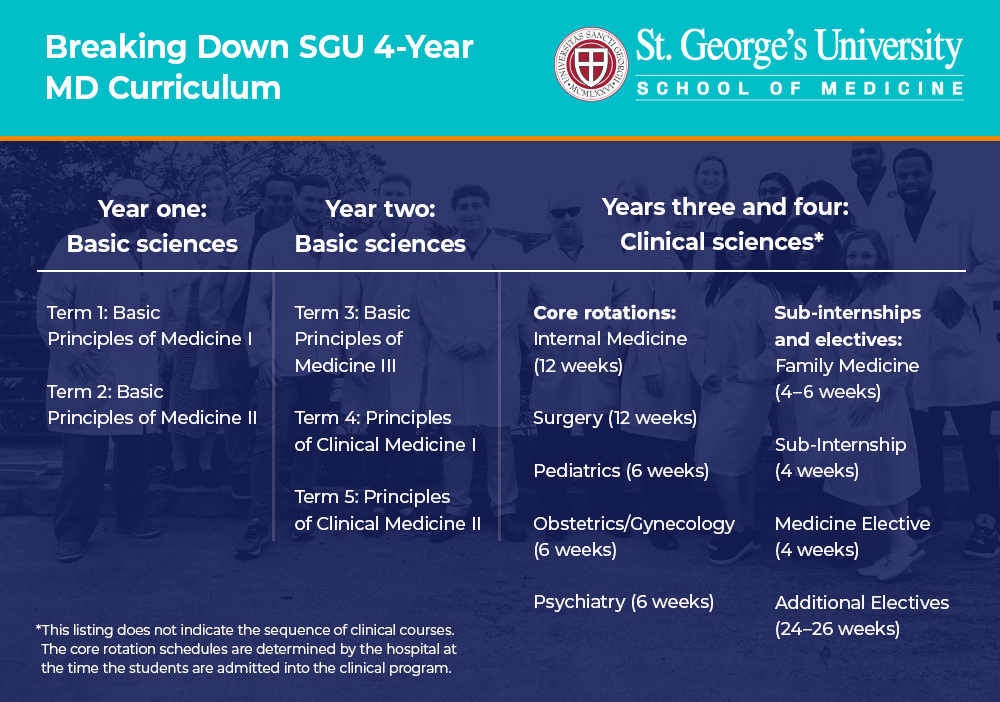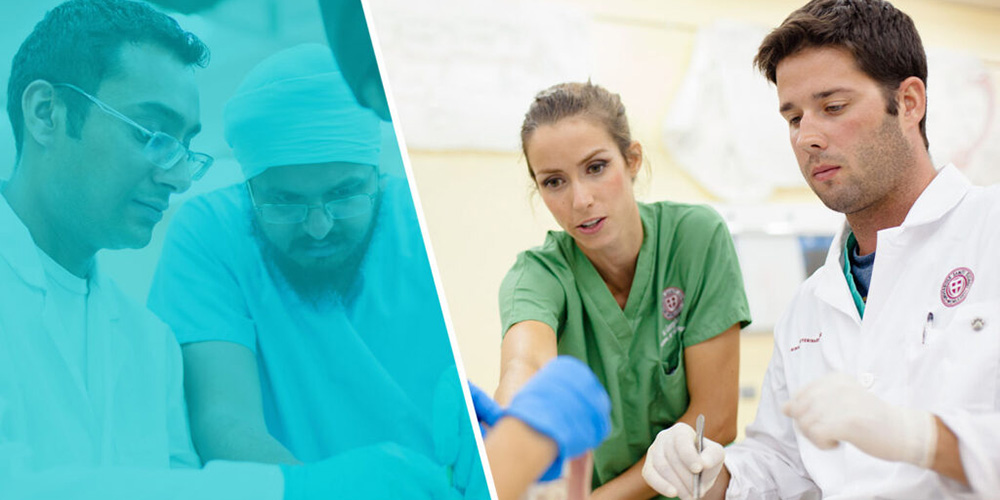Whether you’ve already secured your seat or you’re still working your way through the application process, you’re now looking to learn a bit more about what to expect in medical school. It’s true that each Doctor of Medicine (MD) program is different—but medicine is a very regulated field, which means there are certain subjects and skills all future physicians are required to learn.
There are a few different paths students can take in pursuit of their medical degree. The most common among them, however, is the traditional four-year MD program. Read on for an overview of what St. George’s University (SGU) students can expect from the four-year medical school curriculum by year.
What to expect in medical school: The four-year MD curriculum
Four-year MD programs are generally split into two primary sections, with the first two years spent covering the basic sciences and the final two years spent teaching students more about the clinical sciences. You can expect the course delivery itself to vary among programs, but using this SGU program outline can help give you an idea of what to expect throughout each phase of your time in medical school.

Year one: Basic sciences
- Term 1: Basic Principles of Medicine I
- This 17-credit course is taught over a span of 17 weeks. Topics covered include the foundation of medicine; the musculoskeletal system; and the cardiovascular, pulmonary, and renal systems.
- Term 2: Basic Principles of Medicine II
- This 17-credit course is taught over 18 weeks. Topics covered include endocrinology and reproduction; digestion and metabolism; and neurosciences and behavioral sciences.
Year two: Basic sciences
- Term 3: Basic Principles of Medicine III
- This eight-credit course is taught over a span of six weeks. Topics covered include the basics of immunology and microbiology; public health assessment tools; culture and societal issues/physician-patient relationship; and ethics, professionalism, and medical jurisprudence.
- Term 4: Principles of Clinical Medicine I
- This 21-credit course is taught over 18 weeks. Topics covered include general principles of pathology; pharmacology and microbiology; renal and cardiovascular systems; respirator and hematopoietic systems; and digestive, endocrine, and reproductive systems.
- Term 5: Principles of Clinical Medicine II
- This 23-credit course is taught over a span of 18 weeks. Topics covered include a continuation of the pathological basis of disease in areas like bone and skin, endocrine, neuropathology, forensics, and infant pathology.
- Fifth-term students at SGU can also expect to take a four-credit course to learn the basic sciences foundation for clinical reasoning.
Years three & four: Clinical sciences
- Core rotations: 42 weeks will be spent participating in clinical rotations, where medical students will learn to translate the foundational knowledge they’ve built into clinical skills alongside supervising physicians. The sequence of clinical courses will vary, but students should expect to complete rotations in internal medicine, surgery, pediatrics, obstetrics/gynecology, and psychiatry.
- Sub-internships and electives: After core rotations are completed, students will spend the remaining 38 weeks participating in sub-internships and elective courses. SGU students will also complete a clinical rotation in family medicine and general practice during this time. Sub-internships refer to the clinical rotations fourth-year students pursue at hospitals affiliated with their medical school programs. Elective courses are available for students to select individually.
Final medical school considerations
In addition to the year-by-year outline of a traditional four-year medical school curriculum, there are a few other elements you’ll want to keep on your radar throughout your time in med school. All medical students, for example, will need to sit for the United States Medical Licensing Examination (USMLE) Step 1 and Step 2 before they can apply for residency.
Students should expect to sit for the USMLE Step 1 at the end of their second year of medical school. The USMLE Step 2 focuses more on clinical management, and students can expect to take this phase of the exam after they’ve completed clinical rotations.
It’s also helpful to note that the classic four-year MD program most have grown accustomed to isn’t your only option. The School of Medicine at SGU proudly offers a range of options, from five-, six-, and seven-year MD tracks to dual degree opportunities in which students can earn a master’s degree alongside their MD.
To learn more about the details of these programs, visit the SGU Doctor of Medicine program page.

